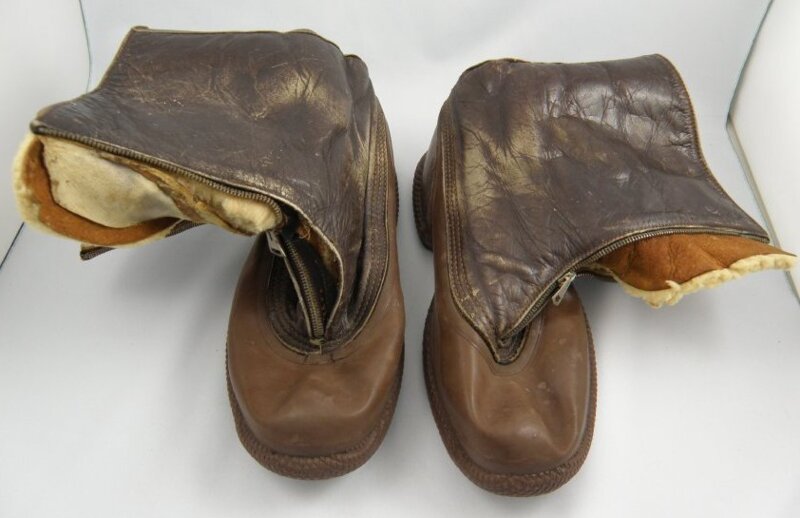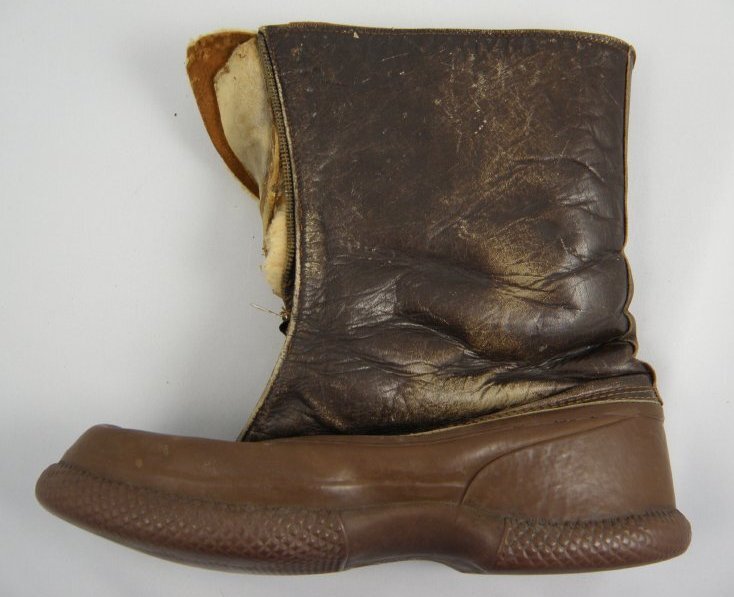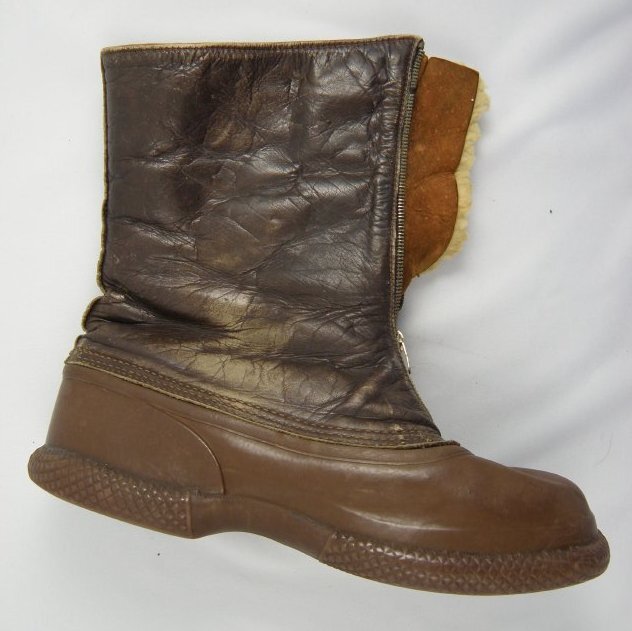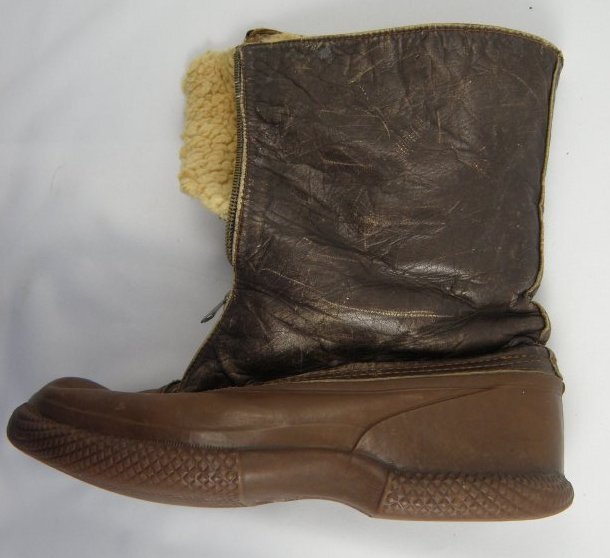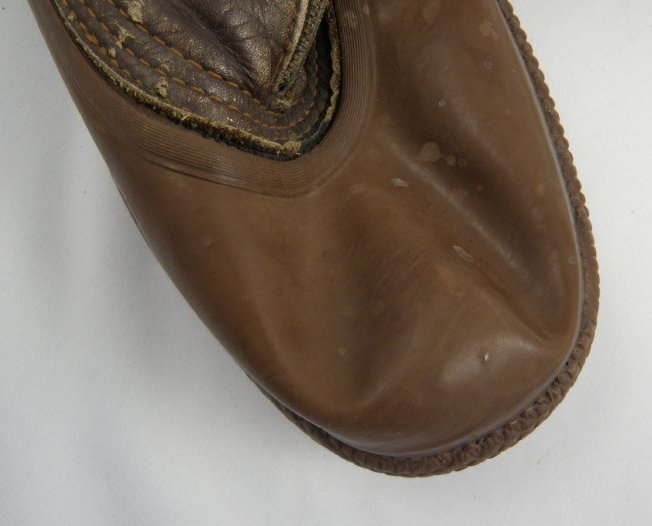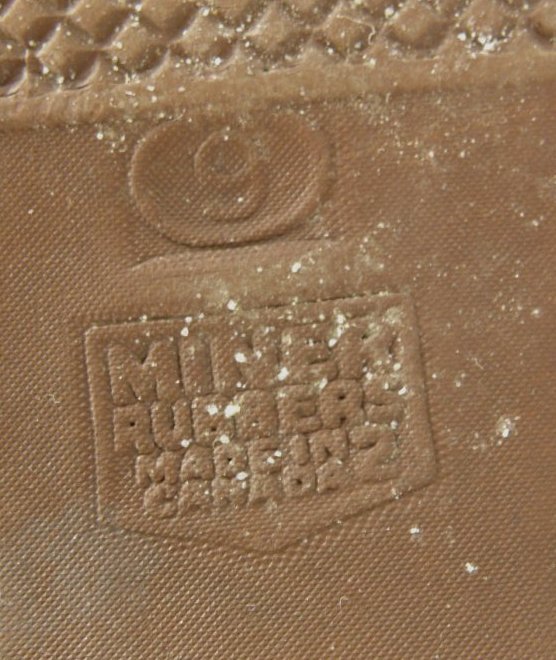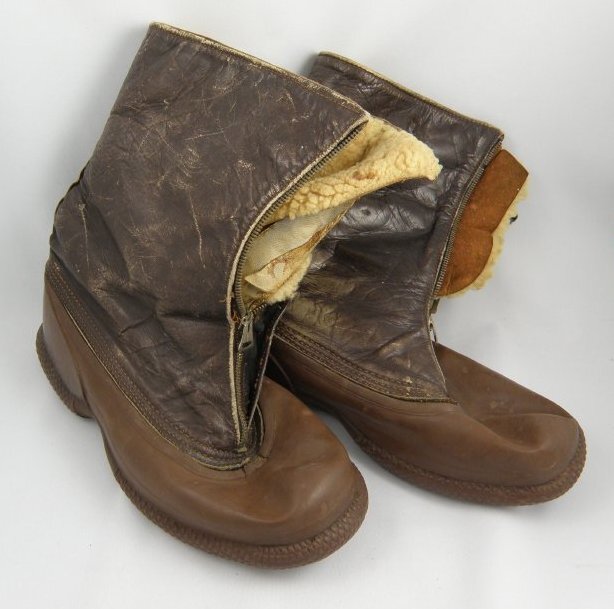Boots
Item
Title
Boots
Description
Pair of brown leather boots with rubber soles. size 9 Manufacturer's mark on bottom of rubber sole reads: MINER RUBBERS MADE IN CANADA 2
Date
Identifier
010.095.001
Medium
Provenance
Belonged to John Joseph "Joe" Beaton information given in an email from donor: .This is a summary of my Dad's experience in the WWI1 : John Joseph "Joe" Beaton - born Nov. 13, 1914 in Harbour View, Nova Scotia. 1936 - Graduated from St. Francis Xavier University, Antigonish, NS - with Bachelor of Science in Chemistry Taught school for 1 yr, then entered Nova Scotia Agricultural College and MacDonald College. After which - worked for the Nova Scotia Department of Agriculture 1941 - enlisted in the Royal Canadian Air Force, volunteering for aircrew, then trained to be a navigator Flying Officer Beaton was posted to the United Kingdom, at Linton-on-Ouse, in Yorkshire. Flew bombing operations over Germany in Wellingtons, and later Lancaster MK11's with 426 "Thunderbird" Squadron in Bomber Command Oct. 7, 1943 on a bombing raid to Stuttgart, Germany, their Lancaster, Number DS.689, was shot down over occupied France by a German D.C.A. The plane crashed near the little village of Rachecourt-sur-Blaise. Six of the crew were killed. Joe helped the 19 year old flight engineer with his parachute, then bailed out last, making a hard landing due to late deployment of his chute. Germans saw the parachutes and pursued them. Joe and Cyril hid and slept in the day and followed creeks to throw off the scent of the dogs. They headed south away from the area and towards their hoped destination of Switzerland. They were spotted on the 8th at dawn by a farmer then spent the day sleeping in some nearby woods. Joe developed back pains from his fall before his parachute opened. As a result, he had to sleep leaning against a tree. They met some farm girls while washing up at a spring who signaled them to wait. They took a chance as they were still wearing their allied air force uniforms. The girls returned in ½ hour with food for them. Again they walked all night, reaching the Etoile Forest by dawn on the 9th where they rested. They set out again at dusk, skirting Meures and Marault, then rested before crossing the Marne River. They crossed near Riaucourt during the night of Oct. 10-11th and took shelter at a farm on the Treix Plateau. Late in the afternoon of the 11th, they approached Chaumont through the woods. The road split. Rather than taking the road to town they selected the old Maladiere Hill road. Not far from there they could hear German soldiers engaged in firing practice. Joe and Cyril stayed to the left and climbed the Robin Forest road hoping to find refuge until nightfall. In the failing light, the two fugitives, who were hiding in some bushes at the edge of the Robin Forest saw a figure approaching, wearing white pants reminiscent of painter pants. His outfit lessened their fear that this man might be a German. So they took a chance and approached him from the bushes, explaining by gesture that they were English airmen whose plane had crashed in the area. They were looking for shelter so they could rest before continuing on to Switzerland by night. The Frenchman, Rene Comminazi, quickly took them to his employer's house, where they were having dinner. Joe and Cyril were introduced to Jean Parisot who was a member of the Giey-sur-Anjon maquis and the Comite de Liberation from its inception. That is how they met and were aided by the French Resistance. Despite living in a German occupied town with the threat of reprisals for assisting the allies, Parisot hid them above his shop while he summoned a Mr. Vigroux who spoke English very well. He needed to check the authenticity of the airmen's information. They were hidden and moved from place to place for 3 months, unable to talk or be seen by anyone incase the person was a Nazi sympathizer. The Resistance created false identification (Joe was listed as a farmer) and French passports for them. Then escorted them to the border on Christmas Eve, and after a few tense moments when they had to pass a group of German Officers at the train station, decided to take a later train. They made their way to the border with their guides where they waded through a river to safety in Switzerland. They were initially arrested, imprisoned and interrogated. Then they were handed over to the British embassy in Berne. They were debriefed and given time to recouperate but unable to return to the war. They were released to England a year to the day of their plane being shot down. After the war Joe became a member of the Canadian Branch of the Royal Air Force Escaping Society, for escapers and evaders of the enemy in war time. Joe was posted to Ottawa after the war, continued as a navigator in the RCAF, flying with "Photo Squadron", photographing northern Canada, and later with 412 (VIP) Squadron. Background: People in a small village saw their plane shot down. Gathered up one of the parachutes and made slips, etc with the it. They tried to hide the location of the wreckage though the Germans also saw the plane go down and eventually found it. The french farmer, Mr. Emile Bertrand was interrogated and tortured by the Germans. He was one of the resistance very involved in hiding the evaders. Many others were also arrested, some killed , some imprisoned and a few released. Villagers collected the bodies of the 6 crewmen who died, gave them a proper burial with head stones. Each year since the war they have held a ceremony in remembrance of the brave crew who gave up their lives so the french could be free. Joe flew 16 missions against the enemy, with the 17 ending over Rachecourt. The biggest raid in which he took part was on Berlin on August 23, 1943. Of the 750 aircraft that participated, 58 failed to return to base.

